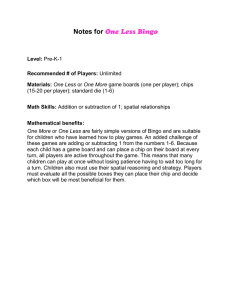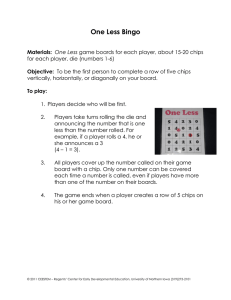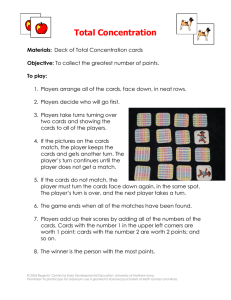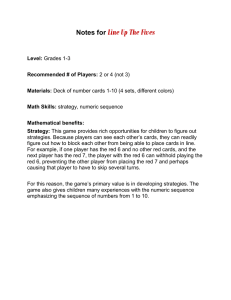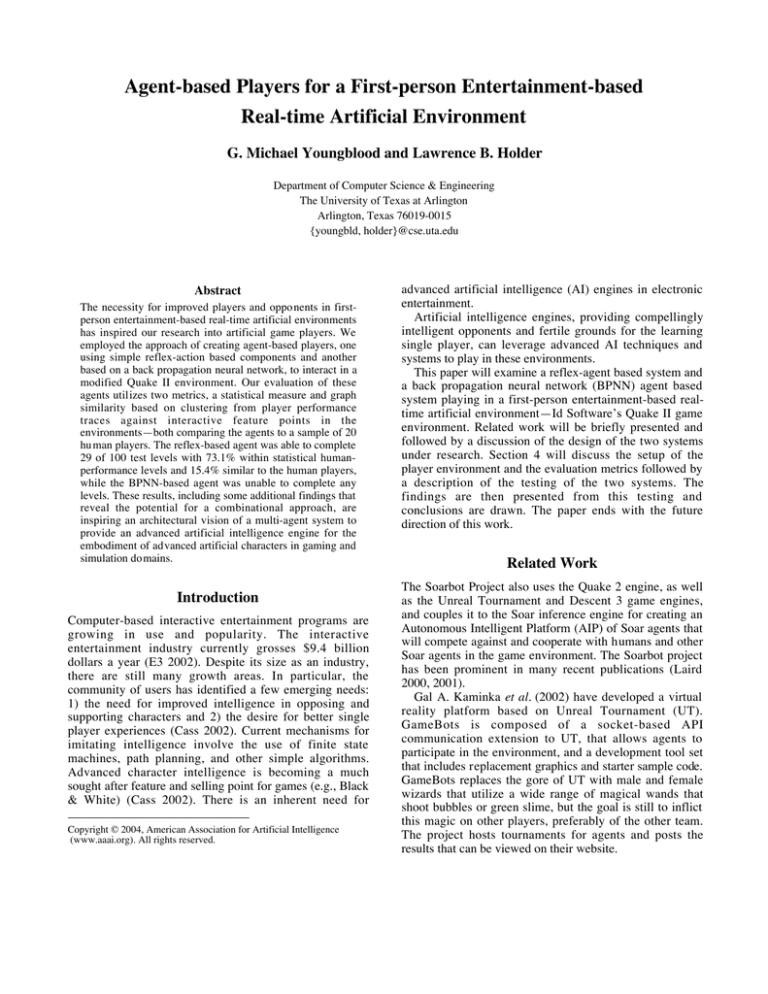
Agent-based Players for a First-person Entertainment-based
Real-time Artificial Environment
G. Michael Youngblood and Lawrence B. Holder
Department of Computer Science & Engineering
The University of Texas at Arlington
Arlington, Texas 76019-0015
{youngbld, holder}@cse.uta.edu
Abstract
The necessity for improved players and opponents in firstperson entertainment-based real-time artificial environments
has inspired our research into artificial game players. We
employed the approach of creating agent-based players, one
using simple reflex-action based components and another
based on a back propagation neural network, to interact in a
modified Quake II environment. Our evaluation of these
agents utilizes two metrics, a statistical measure and graph
similarity based on clustering from player performance
traces against interactive feature points in the
environments—both comparing the agents to a sample of 20
hu man players. The reflex-based agent was able to complete
29 of 100 test levels with 73.1% within statistical humanperformance levels and 15.4% similar to the human players,
while the BPNN-based agent was unable to complete any
levels. These results, including some additional findings that
reveal the potential for a combinational approach, are
inspiring an architectural vision of a multi-agent system to
provide an advanced artificial intelligence engine for the
embodiment of advanced artificial characters in gaming and
simulation domains.
Introduction
Computer-based interactive entertainment programs are
growing in use and popularity. The interactive
entertainment industry currently grosses $9.4 billion
dollars a year (E3 2002). Despite its size as an industry,
there are still many growth areas. In particular, the
community of users has identified a few emerging needs:
1) the need for improved intelligence in opposing and
supporting characters and 2) the desire for better single
player experiences (Cass 2002). Current mechanisms for
imitating intelligence involve the use of finite state
machines, path planning, and other simple algorithms.
Advanced character intelligence is becoming a much
sought after feature and selling point for games (e.g., Black
& White) (Cass 2002). There is an inherent need for
Copyright © 2004, American Association for Artificial Intelligence
(www.aaai.org). All rights reserved.
advanced artificial intelligence (AI) engines in electronic
entertainment.
Artificial intelligence engines, providing compellingly
intelligent opponents and fertile grounds for the learning
single player, can leverage advanced AI techniques and
systems to play in these environments.
This paper will examine a reflex-agent based system and
a back propagation neural network (BPNN) agent based
system playing in a first-person entertainment-based realtime artificial environment—Id Software’s Quake II game
environment. Related work will be briefly presented and
followed by a discussion of the design of the two systems
under research. Section 4 will discuss the setup of the
player environment and the evaluation metrics followed by
a description of the testing of the two systems. The
findings are then presented from this testing and
conclusions are drawn. The paper ends with the future
direction of this work.
Related Work
The Soarbot Project also uses the Quake 2 engine, as well
as the Unreal Tournament and Descent 3 game engines,
and couples it to the Soar inference engine for creating an
Autonomous Intelligent Platform (AIP) of Soar agents that
will compete against and cooperate with humans and other
Soar agents in the game environment. The Soarbot project
has been prominent in many recent publications (Laird
2000, 2001).
Gal A. Kaminka et al. (2002) have developed a virtual
reality platform based on Unreal Tournament (UT).
GameBots is composed of a socket-based API
communication extension to UT, that allows agents to
participate in the environment, and a development tool set
that includes replacement graphics and starter sample code.
GameBots replaces the gore of UT with male and female
wizards that utilize a wide range of magical wands that
shoot bubbles or green slime, but the goal is still to inflict
this magic on other players, preferably of the other team.
The project hosts tournaments for agents and posts the
results that can be viewed on their website.
Other work in this area includes many of the developed
game bots for first-person shooter (FPS) games. Neural
networks (NN) are very widely used and research
involving their use in robotic and classic games (e.g.,
robotic soccer, chess) are publicly available. The gaming
AI community also has online tutorials specifically for
using NNs in FPS games (Champandard 2003).
Multi-agent System Players
Interfacing with the Quake II engine proved to be a
challenge due to intolerance of the game engine for time
lags. A design decision was made to make the AI engine be
completely separate from the game. Having enough
processor power to not interfere with the demands of the
game created a problem that was solved by distributing the
system between two machines. Furthermore, there was a
desire to make every component of a system be
independent and swappable with different components
(agents) that may provide improved and different
capabilities. It is envisioned that these agents, each
performing a specific task, would create a connectionist
network. Thus, a multi-agent system (MAS) approach was
taken.
order to perform adequately or as designed (e.g., the
memory model is just a storage model, but it may not be
useful without a perceptual model to supply information to
store or a learning model to form higher-level knowledge
for storage).
The DCA is an architecture consisting of basic model
types that may exist in multiple forms (with the exception
of the attention model provided by CAMS) that comprise
the nodes of a connected, directed graph.
In this phase of our research, we have focused on
creating a base reflex agent utilizing the subsumption
architecture (Brooks 1986). To facilitate a basic agent
system, the basic nodes that exist in the current DCA are
the action, attention (provided by CAMS), effector,
memory, percept, and reflex. Figure 1 shows the
configuration of the DCA reflex-based agent—the arrows
in the figure represent lines of communication.
CAMS
The Cognitive-based Agent Management System (CAMS)
architecture was designed to meet the requirements of a
multi-agent system (MAS) for creating a game-playing AI
engine. Due to moving towards a cognitive basis for this
work, the real-time requirements for interaction with
Quake II, and the speed and object-oriented methodology
of C++, there was a need for a custom MAS since no
current systems offered a usable solution.
The CAMS infrastructure provides an agent framework
for agent implementation that focuses on the management
interface to an agent, an a ttention agent that acts as the
local agent society supervisor, and a bootstrap agent that
facilitates the movement (starting and restarting of agents)
on different machines.
The CAMS attention agent has the ability to control the
agents within its agent society, change their priority levels,
control their communication links to other agents, and
establish anytime processing constraints.
DCA Reflex-based Agent
The invention and development of CAMS set the stage for
the creation of agents to populate a system for playing
Quake II. Using the human player as a model we intend to
employ work from human cognitive research to form an
agent society into the D’Artagnan Cognitive Architecture
(DCA, named after Dumas’ hero in The Three Musketeers).
The DCA consists of distinct areas of focus or models of
cognition centered on a specific task that when connected
form an architectural system for interacting in an
environment. Each model is independent and should work
on its own, but may require help from the other models in
Figure 1. DCA Reflex-based Agent Configuration
The perceptual input node brings in all information from
single or various sources into the architecture. Any
preprocessing of information is done in the perceptual
input (e.g., data conversions, data expansions, spatial
representation). In the Quake II environment, percepts
include all of the information coming from the game
engine for the player (e.g., position, health, inventory, etc.).
The memory model node receives the perceptual
information and stores it into short-term memory (STM)
for access by all nodes. The memory model may then
commit some information to long-term memory or perform
other actions. We currently have only established the use
of STM which currently acts only as percept data storage
for agent access.
Upon the receipt of percepts and storage into memory
for availability to all nodes, the functional nodes that watch
and wait for new information in memory start processing.
The reflex agent, which uses subsumption architecture,
provides a reactive action to the action agent. The action
agent determines the best action to take at any given
moment based on the input. In our reflex-based model this
will merely echo the reflex action.
The reflex agent’s subsumption architecture contained
several behavior layers. This agent did maintain a small
amount of state information, so was not purely reactive, but
generated some internal sensory information such as
whether or not it had been stuck in the same position for a
while. At the lowest level the agent would perform a
random motion movement with a preference to move
forward and rotate left on its axis. If the agent was close to
a goal it was provided positional data and could then sense
it as a percept, moving towards the goal. These goals
included opposing forces, and when in range, the agent
would fire its stun gun. If the agent was stuck, then it
would perform a maneuver to become unstuck. At the
highest level, if the agent was dead, it would not perform
any action. Through these layers actions were generated.
The effectors node takes the ultimate action produced
from the action model (reflex agent) and performs that
action. In the Quake II environment, this is seen as
movement, firing, or other actions allowed by the game
engine.
Information comes into the DCA, is stored, processed,
and resolved into an action, which is acted upon. This cycle
repeats until the agent dies or is stopped either by game
completion or operator intervention.
BPNN Agent
In contrast to the CAMS-DCA system, we also developed a
CAMS-BPNN (back propagation neural network) agent as
a comparison approach. This system utilized the same
architecture as described in the previous section with the
exception that the BPNN agent replaces the reflex agent.
The BPNN agent was implemented in two stages. The
first stage was to develop a training program that would
read in the training data set. The network would then be
trained, setting the weights of the connections until
convergence below the specified mean-square error. The
second stage was an execution engine that could load the
weights and run the network based on an input vector,
producing an output vector. The second stage is wrapped in
the CAMS-DCA shell to allow it to receive percepts which
are then encoded in binary as an input vector to the
network which would produce an output vector that is then
deciphered into (a) corresponding action(s).
The project has collected twenty data sets of humans
playing each of the designed scenarios. This information
was converted into training data for the neural network.
The core perceptual information needed to make a
movement decision is the player’s current x and y position
in the scenario and their current heading or yaw, h, giving a
29-bit input for any given position in the environment.
The target output is the action taken, which is
represented in a 17-bit classification scheme of which each
bit represents a specific action. A rule-based program was
developed to take the raw player data and generate this
encoding scheme. All of the player data was then
concatenated together into a single training set of 3639
examples.
The BPNN implementation specifically employs the use
of a logistic function as the node transfer function between
both hidden and output layers. For this work, the bias term
is set to zero, and the momentum term is set to one. Due to
well-documented reasons of the feasibility of the network
to approach the limit of a one or zero value in application
(Levine 2000; Rumelhart, Hinton, and Williams 1986), we
consider anything over 0.9 to be 1 and anything less than
0.1 to be 0.
The network follows a standard BPNN algorithm during
training, and then uses the calculations from input through
the hidden to the output layer based on the trained weights
to convert network input into network output (i.e., position
information into action information).
The BPNN was trained on the training data set of 3639
examples (it should be noted that this represents actions in
only 0.00044375% of the possible 144,000,000 positions,
many duplicated), which were collected from human
players as described in the next section. The number of
hidden nodes was set to values between 1 and 30 and run to
convergence. The effect of more nodes increases the rate of
convergence but causes the network to be less general
(Levine, 2000). In application, networks with more than 3
hidden units often could not generalize in the applied
environment, so a 29-3-17 network was used for all further
evaluations. Minimum mean-square error was set at 0.001
for all training runs. Evaluation of the network training was
compared to the training data set to determine if the
network learned the training data set. The training set was
reused due to a lack of additional data and the desire to put
as much known data into the training set.
Results indicate that the networks could learn the
training set with a consistent 88% accuracy. The learning
rate was varied from 0.1 to 0.3 in a 29-3-17 network.
Contrary to literature (Levine 2000) indicating that
oscillations usually occur with high learning rates, we did
not observe this phenomenon. Regardless, we chose a 293-17 network with a learning rate of 0.2 and a minimum
mean-square error of 0.001 for our agent network. The full
test would come from the integration and interaction with
the Quake II environment.
System Evaluation Methods
The two metrics we employ for evaluation become the
basis for our claims on performance and consistency. The
Time-Score metric taken over a trial set of evaluated
human players will create a data set that will allow for
statistical analysis. For each level we compute the
maximum and minimum values of the combined TimeScore metric over the trial set of human players. If another
player falls within that range for a specific level we shall
say that they were within the range of human performance.
We define human-similarity through the utilization of
our clustering metric to be the property of being clustered
in the same group as another human player. This means
that there exists a strong enough similarity in time and
traversal through a specific Quake II trial level that players
are clustered together in the evaluation environment.
Evaluation Environment
A test set of one hundred Quake II levels was created
starting with simple one-room environments and
culminating in five levels that represent the typical
difficulty of the original game. Each level was created to
slowly introduce new concepts starting with very simple
levels and gradually working up to the last five challenge
levels. The goal of each level was to find a compact disc
(CD). All players were told to maximize their health by not
receiving damage and collecting health points, and to move
through the levels as quickly as possible. Each level is
independent, and the player state is reset upon entry in the
next level. An example test level is shown in figure 2.
each level’s interaction feature points as nodes, and the
ability to move from one interaction feature point to
another would create the edges as was physically possible
in each level. For each level, the interaction feature points
were identified and a valid state transition diagram (e.g.,
figure 2.b) was generated for additional validations.
One problem with the graph representation is that there
is a definite issue of timing in games such as Quake II, and
often the real difference between performances in a level is
the time it takes different players to accomplish the same
task. Gonzalez (1999) and Knauf et al. (2001) also note the
importance of time in validation of human models. We
capture time by weighting the edges a player traverses
between interaction feature points with the time it had
taken the player to travel that. Now we can abstract a
player’s performance in a level, removing the noise of
motion through the environment, and capturing their
approach of interaction—moving from one interaction
feature point to another in a level while also capturing the
time aspect of their performance.
Data Evaluation Metrics
a)
b)
Figure 2. Scenario a) 3D view b) valid state transitions.
Human Trial Data
We found twenty people willing to participate in our
Quake II human trials. A large amount of data was
collected which consisted of the name, position in threedimensional space, and state information for every active
object in the Quake II environment updated at a rate of 10
Hz. We needed to determine a way to represent a player’s
interaction in the Quake II environment for each level in a
way that made it easy to compare players to other players.
Observing the test set of levels we created, we noted that
we could break down each level into a set of interaction
feature points based on attaining or doing certain things in
each level (e.g., pushing a button, picking up a health item,
and so forth). These interaction feature points were all of
the objects in each level that a player could interact with
and that were tracked as individual objects by the game
engine. Using this we could generate a graph composed of
We developed two metrics for the evaluation of the data.
The first metric produces a gross indicator of relative
performance on each level based on the overall goals of
maximizing the player’s health and minimizing the time
spent in each level. The second evaluation metric uses the
graph data generated from each level for each player and
generates a matrix of edit distances between all players to
serve as the distance function for use in k-means clustering
(Friedman and Kandel 1999). By clustering player
performance, we hoped to see clusters of players grouped
by their relative skill level. If we evaluate agent trial data
with human trial data and the agents cluster into groups
with human players, then we can assert that the agent
played similar to that group of humans. If a player or agent
constantly appears in the same cluster in a clustering over
several levels, then we could classify the player or agent by
its group associated performance.
We generated a matrix of edit distances between player
graphs over all players for each level. K-means clustering
was performed for each level. We seeded our initial cluster
centers with random members of our data set, and we
iterated our clusters over all possible initial seed values.
We utilized the normalized mean intra-cluster distance
(Zhao and Karypis 2002) as the clustering quality measure
and exercised k from 2 to (n-2), where n is the number of
trials by humans and/or agents, over the data set to ensure
we find the best clustering. The resultant clusters are used
to group players by the similarity of their performance in
the game.
Further details of this evaluation methodology can be
found in Youngblood and Holder (2003).
Agent Trials
Trials were run on the CAMS-DCA reflex-based agent
over the 100 test levels of the evaluation environment and
data collected in the same manner as the human trials. The
CAMS-BPNN agent was first tried on a single scenario to
test for fitness to compete in the rest of the levels. Only
completed levels were subject to the metric evaluations
described in section 4.
Performance
Understanding the data is key to understanding the results
of clustering. We have taken data with a very high degree
of dimensionality in the form of a graph and generated a
distance metric between these graphs in this highdimensional space.
Generating a data set for comparison when there are an
infinite number of combinations of choices in each level is
difficult. Our human trial data set suffers from its small
size, but is sufficient for clustering other similarly
behaving humans. However, there may exist human
players that may not be classified with the current set of
players. What we present is an objective form of evaluating
performance against a particular set of humans and the
means to test human-similarity within the boundaries of the
known human models captured in the system.
The Time-Score metric is presented as a means for
identifying if a new player falls within the band of human
performance. The clustering metric is for determining
human-similarity. Both metrics are based on a set of fixed
procedures and the use of a trial human data set.
Using the presented Time-Score and Clustering metrics
we have been able to evaluate the agent systems presented
here.
DCA Reflex-based Agent
The CAMS-DCA reflex-based system was at its best able
to complete 27 of the 100 test levels. The reflex-based
agent completed 73.1% of its completed levels within
human performance levels, and 15.4% were performed in a
human-similar manner. In a side experiment we also
introduced a concurrent random action generating agent
that intermixed actions with the reflex agent for some
additional interesting results. The combination reflexrandom agent completed 69.0% of its completed levels
within human performance levels, and 3.4% were
performed in a human-consistent manner, but as a
combined system was able to complete 29 test levels.
BPNN Agent
Interacting with the Quake II environment seemed to be a
challenge for the CAMS-BPNN agent. There were no
problems in receiving input or providing output, but the
type of output the BPNN produced did not allow the agent
to perform well in the environment. Using the base 29-317(0.2:0.001) network, the agent had a tendency to turn
left. Concerned, we examined the training data to discover
that the majority of moves were indeed left turns. In the
absence of a known position to elicit a learned action, the
network generalized the unknowns to left turns—a logical
conclusion. To reduce this effect, we also modified the
agent to perform a random action when it had an activation
value of less than 0.90 over all outputs (since there was
never a zero output case). This caused the agent to progress
a little and the random action was usually only momentary.
Under this progression it was observed that the network did
actually generate actions when it came across a state that it
had learned and was not generalizing—the random acts
tended to move the agent out of local movement minima
(i.e., stuck turning left forever). Unfortunately, this is just
not enough to successfully play a Quake II
level—especially, when there are elements of danger in the
environment
Another issue arises in that the training data is an
accumulation over 20 human players’ actions and may
contain inconsistencies or contradictions for a given state
and the action to take. The majority should rule, but since
the training set was extremely small in comparison to state
space size, they most likely caused states with no clear
action to take. We evaluated training on just the examples
from a single player, but there was little difference—most
likely a result of such a small training set in comparison to
the size of the state space. What was interesting is that
different individual players tended to have different
common moves, so generalization on a single player basis
yielded different general movements for the network.
In general, the agent did learn the training set to 88%
accuracy, was integrated into the Quake II environment,
generated actions based on input in real-time, and survived
for a while in the test environment but was unable to
complete any of the levels. Due to the inability of the agent
to complete the scenario, the advanced evaluation
techniques were not utilized.
Conclusions
Through the production of a Time-Score metric as an
overall performance evaluation and a clustering metric for
determination of human-similarity, we provided a means to
evaluate players and agents in the Quake II environment.
We first showed a general classification of system
performance as compared to a defined set of human
acceptable performance ranges and the ability to cluster a
player’s performance with those that played in a highly
similar manner. This includes the evaluation of temporal
performance as well as a spatial approach to sub-goal
problem solving in those environments. The resulting
clusters of players have a clear connection to performance
in such environments and provide a means of classification
based strictly on performance groups. These evaluations
are conducted solely through numerical analysis in a
defined process and do not contain any steps of subjective
evaluation.
Evaluation of our CAMS-DCA system employing a
reflex agent, and in parallel a combination random-reflex
agent, showed that this system was at its best able to
complete 29% of the levels. The reflex agent completed
73.1% of its completed levels within human performance
levels, and 15.4% were performed in a human-similar
manner. The combination agent completed 69.0% of its
completed levels within human performance levels, and
3.4% were performed in a human-similar manner. We
observed an 11.5% increase in the ability to complete
levels through the use of the combined agent over the best
performance of the reflex agent alone. The ability of this
system to improve performance through a combination of
agents hints at a Gestalt factor to this approach.
A 29 input, 3 hidden, and 17 output node back
propagation neural network with a learning rate of 0.2 and
minimum mean-square error of 0.001 was developed and
trained using the 3639 examples from 20 human players’
actions. The CAMS-BPNN system did provide valid
movement actions, but often required some additional help
to produce output. The actions generated, however, did not
seem to be goal progressing. The major problem seems to
stem from a lack of training examples to sufficiently train
the network given that the existing training set, at most,
only covers a small fraction of the state space. Overall, the
results are promising for the future use of neural networks
in electronic entertainment artificial intelligence as the
system was very fast and performed well with what
knowledge it had learned. In the end, a neural network is
only as good as its training data and this type of problem
would appear to require a large amount of consistent data
to be effective.
Utilizing a two-part evaluation metric and a multi-agent
based simple reactive system yielded promising results and
an evaluation mechanism toward generating better
computer generated forces for electronic entertainment and
simulation.
Future Work
Our future work involves completing an expanded full
implementation and testing of the DCA; growing the
maturity of CAMS through further study, development,
testing, utilization, and research; working to optimize the
clustering criterion function for our player clustering;
streamlining and automating the trial and evaluation
process; and improving the reference test level set. Some of
the problems we observed are due to our small sample
size—we need to bring in a much larger set of human trial
data.
However, our future work is not utilizing the Quake II
environment, but instead is using a popular community
developed game called Urban Terror by Silicon Ice
Development based on the Quake III game by Id. This new
environment provides richer and more real-world scenarios
with a terrorist/counter-terrorist theme that is currently a
popular genre of games and may also tie into better
simulations for investigating current security problems in
today’s society. With support from the Urban Terror online
community we are also working to build a human-player
database from player volunteers from around the world.
We hope that this research will lead to better artificial
players to enhance online and offline game play.
References
Brooks, R. A. 1986. A robust layered control system for a mobile
robot. IEEE Journal of Robotics and Automation, RA-2:4-23.
Cass, S. 2002. Mind games. IEEE Spectrum (39:12). Piscataway,
NJ: IEEE.
Champandard, Alex. J. 2003. Bot Navigation: Neural Networks
for
Obstacle
A v o i d a n c e . Online at http://aidepot.com/BotNavigation/Obstacle-Introduction.html.
E3 Expo. 2002. Electronic Entertainment Expo. Framingham,
MA: E3 Expo.
Friedman, Menahem and Abraham Kandel. 1999. Introduction to
Pattern Recognition: Statistical, Structural, Neural, and Fuzzy
Logic Approaches. London: Imperial College Press.
Gonzalez, A. 1999. Validation of Human Behavioral Models. In
Proceedings of the 12th International Florida AI Research Society,
489-493. Menlo Park, CA: AAAI Press.
Kaminka, G. A., M. M. Veloso, S. Schaffer, C. Sollitto, R.
Adobbati, A. N. Marshall, A. Scholer, and S. Tejada. 2002.
GameBots: A Flexible Test Bed for Multiagent Team Research.
Communications of the ACM 45 (1): 43-45.
Knauf, Rainer, Ilka Philippow, Avelino Gonzalez, and Klaus
Jantke. 2001. The Character of H uman Behavioral Representation
and Its Impact on the Validation Issue. In The Proceedings of the
14th Intern ational Florida AI Research Society, 635-639. Menlo
Park, CA: AAAI Press.
Laird, John. 2002. Research in Human-Level AI Us ing Computer
Games. Communications of the ACM 45 (1): 32-35.
Laird. J. E. 2001. Using a Computer Game to Develop Advanced
AI. Computer 34(7):70-75.
Levine, D. S. 2000. Introduction to Neural and Cognitive
Modeling. Mahwah, NJ: Lawrence Erlbaum Associates.
Rumelhart, D. E., Hinton, G. E., and Williams, R. J. 1986.
Learning internal representations by error propagation. Parallel
Distributed Processing (Vol. I, pp. 318-362). Cambridge, MA:
MIT Press.
Youngblood, G. M. and Holder, L. B. 2003. Evaluating HumanConsistent Behavior in a Real-time First-person Entertainmentbased Artificial Environment. In The Proceedings of the 16th
International Florida AI Research Society, 32-36. Menlo Park:
AAAI Press.
Zhao, Ying and George Karypis. 2002. Evaluation of Hierarchical
Clustering Algorithms for Document Datasets. Technical Report
02-022. Minneapolis: University of Minnesota.

